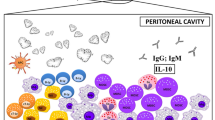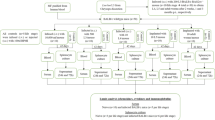Abstract
The immunological events that occur during the initial stages of experimental cysticercosis are not known. The studies presented here examined the cytokines produced by peritoneal exudate cells (PECs), splenocytes and mesenteric lymph node (MLN) cells during the first week of infection with larval Taenia crassiceps in BALB/cJ mice. Proliferation assays determined that the earliest time when antigen-specific responses could be measured was 5 days post-infection. Concanavalin A (ConA) stimulation of host cells elicited an initial burst of IL-4 production at 24 h of infection and ConA-stimulated Th2-type cytokine production is predominant by 7 days post-infection. Thus, there are responses at day 1 of infection that seem to promote a Th2-type response. Stimulation of MLN cells, splenocytes and PECs with larval antigens supported previous reports of mixed Th1/Th2-type cytokine production with increases in interleukin (IL)-4, IL-10 and interferon (IFN)-γ. Ex vivo IFN-γ production by PECs from infected mice was increased at 3, 5 and 7 days post-infection, whereas at these times reduced ex vivo IL-10 production was observed. This ex vivo IFN-γ response preceded an increasing IL-10 production by PECs between 3 and 7 days post-infection in parasite-specific and ConA-induced proliferation assays. Thus, infection with larval T. crassiceps results in an initial response mediated by IFN-γ that is quickly followed by an increase in IL-10 production and subsequent reduction in the amount of IFN-γ being produced.







Similar content being viewed by others
References
Bojalil R, Terrazas L, Govezensky T, Sciutto E, Larralde, C (1993) Thymus-related cellular immune mechanisms in sex associated resistance to experimental murine cysticercosis (Taenia crassiceps). J Parasitol 79:384–389
Cruz-Revilla C, Rosas G, Fragoso G, Lopez-Casillas F, Toledo A, Larralde C, Sciutto, E (2000) Taenia crassiceps cysticercosis: protective effect and immune response elicited by DNA immunization. J. Parasitol 86:67–74
Freeman R (1962) Studies on the biology of Taenia crassiceps (Zender 1980) Rudolphi, 1810 (Cestoda). Can J Zool 40:969–990
Hermanek J, Prokopic J (1989) Influence of thymic preparations of the result of experimental infection with Taenia crassiceps (Zeder, 1800) in ICR mice. Folia Parasitol 36:331–340
Larralde C, Morales J, Terrazas LI, Govezensky T, Romano M (1995) Sex hormone changes induced by the parasite lead to feminization of the male host in murine Taenia crassiceps cysticercosis. J Steroid Biochem Mol Biol 52:575–580
Mosmann TR, Coffman RL (1989) Th1 and Th2 cells: different patterns of lymphokine secretion lead to different functional properties. Annu Rev Immunol 7:145–173
Mosmann TR, Sad S (1996) The expanding universe of T-cell subsets: Th1, Th2 and more. Immunol Today 17:138–146
Paul WE, Seder RA (1994) Lymphocyte responses and cytokines. Cell76: 241–251
Robinson P, Atmar RL, Lewis DE, White AC (1997) Granuloma cytokines in murine cysticercosis. Infect Immun 65:2925–2931
Spolski RJ, Corson J, Thomas PG, Kuhn RE (2000) Parasite-secreted products regulate the host response to larval Taenia crassiceps. Parasite Immunol 22:297–305
Terrazas LI, Bojalil R, Morales J, Govezensk YT, Larralde C (1998) Shift from an early protective Th1 immune repsonse to a late permissive Th2 response in murine cysticercosis (Taenia crassiceps). J Parasitol 84:74–81
Terrazas LI, Cruz M, Rodriguez-Sosa M, Bojalil R, Garcia-Tamayo F, Larralde C (1999) Th1-type cytokines improve resistance to murine cysticercosis caused by Taenia crassiceps. Parasitol Res 85:135–141
Toenjes SA, Spolski RJ, Mooney KA, Kuhn RE (1999a) The systemic immune response of BALB/c mice infected with larval Taenia crassiceps is a mixed Th1/Th2-type response. Parasitology 118:623-633
Toenjes SA, Spolski RJ, Mooney KA, Kuhn RE (1999b) γδ T cells do not play a major role in controlling infection in experimental cysticercosis. Parasitology 119:413–418
Villa OF, Kuhn RE (1996) Mice infected with the larvae of Taenia crassiceps exhibit a Th2-like immune response with concomitant anergy and downregulation of Th1-asociated phenomena. Parasitology 122:561–570
Acknowledgement
This research was supported by grant AI 35730 from the U.S. National Institutes of Health.
Author information
Authors and Affiliations
Corresponding author
Rights and permissions
About this article
Cite this article
Toenjes, S.A., Kuhn, R.E. The initial immune response during experimental cysticercosis is of the mixed Th1/Th2 type. Parasitol Res 89, 407–413 (2003). https://doi.org/10.1007/s00436-002-0788-z
Published:
Issue Date:
DOI: https://doi.org/10.1007/s00436-002-0788-z




